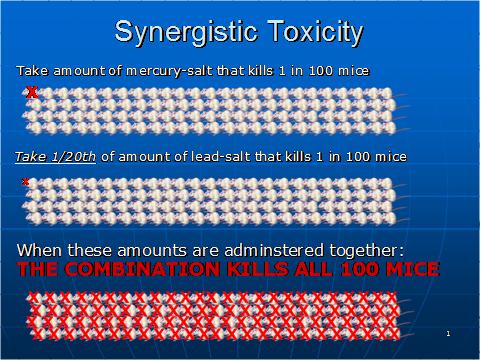
How can 1 + 1 = 100? “Synergistic toxicity” refers to the effect that when exposed to two toxins, the toxicity level is far greater than the additive toxicity levels of the two toxins.
A good example demonstrating ‘synergistic toxicity’ is a 1978 study on mice (Shubert et al. Combined Effects in Toxicology – A Rapid systematic Testing Procedure: Cadmium, Mercury & Lead. J. of Toxicology & Environmental Health 4:763, 1978). The study took the amount of mercury salt that kills 1 in 100 mice and 1/20th of the amount of lead salt that kills 1 in 100 mice. When these amounts of mercury salt and lead salt were administered, the synergistic toxicity of these two toxins killed 100 in 100 mice:
If Additive toxicity, one would expect 1 + 0.05 = 1.05 mice to die (1 or 2)
With Synergistic toxicity, the results were: 1 + 0.05 = 100 mice died
It is important to understand the concept of ‘synergistic toxicity’, as research is increasingly showing that different toxins are typically synergistic rather than additive in the human body. However when testing is performed on a toxicity of a substance, the ‘level of harm’ is set based on an assumption that the substance is the only toxin to which he body is being exposed.
The text below has been edited to represent dental mercury and synergistic toxicity.
There is significant potential for unexpected ‘synergistic toxicity’ effects from dental mercury, which represents the largest exposure to mercury in over 120 million Americans, but particularly for a susceptible population that may already have high toxin levels due to a lessened ability to excrete toxins.
Yet the synergistic toxicity of dental mercury has not been studied. Further, the toxicity of an environmental toxin is generally studied independently of other toxins, although the few studies on combining toxins typically show a strong synergistic toxicity effect.
In other experiments the addition of aluminium, antibiotics, thimerosal and testosterone increased the toxicity of mercury significantly [Haley 2005, 2006].
- Haley B & Small T. Biomarkers supporting mercury toxicity as the major exacerbator of neurological illness, recent evidence via the urine prophyrin tests. Medical Veritas 2006; 3: 1-14.
- Haley B. Mercury toxicity: Genetic susceptibilities and synergistic effects. Medical Veritas 2005; 2: 535-542.

